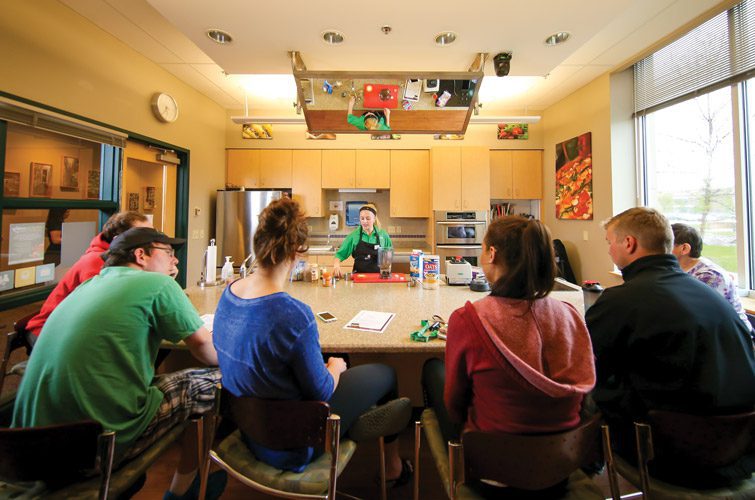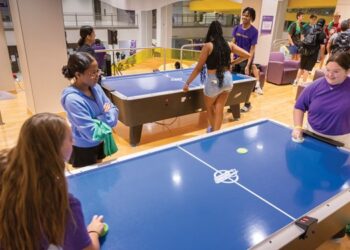If there’s anything trending in campus recreation right now, it’s wellness. From programming for students and staff to spaces and visual design, three campus recreation professionals share how they are providing the best wellness options for their campus communities.
Programming
At Rice University in Houston, Texas, Alex Faris, the assistant director of fitness and wellness, has noticed great growth in participation of mind-body-based programming. “There is a great interest in The Alexander Technique when it comes to people who are in performance-based practices, people such as music majors and those involved in sports performance,” he said. “It brings mindful presence to movement.”
More specifically, Faris described the program as a way to bring awareness to small muscles in the body that control movement, making participants better aware of posture. “It can be everyday movements, like sitting in a chair with right alignment, or if you go to pick up your instrument, being mindful and present as you do that,” he elaborated.
Another specialty class offered under mind-body programming at Rice is called Primal Movements. “It’s coming up in popularity, but it is basic human movement combined with functional movement and mindful awareness,” shared Faris. “We’ve been doing demo classes with this format and there’s a lot of interest because it helps work on posture and natural movements. Think yoga meets different bodyweight activities — you will crawl, do different arm balances, squats, etc.”
And not to be forgotten is classic mind-body programming most rec centers are currently offering: yoga, Tai chi and Pilates. While Rice offers a variety of these programs, they decided to take it one step further and invest in two Pilates Reformer machines. “They allow for different natural movements and can be adapted to many body types,” said Faris. “It’s not like the typical weight machine you find in a gym.”

Taking mind-body programming one step further, the University of North Dakota (UND) offers Zen in 10 as part of their staff wellness program. “We will have a yoga instructor go to various parts of campus and encourage staff to leave their offices and try a quick 10-minute light yoga stretch, just to get them up and moving, increase their heart rate, and get them to relax,” said Christopher Suriano, the director of wellness and health at UND. “We try to bring it to staff, so we offer it near different academic and administrative buildings on campus.”
Because wellness affects all of the campus community, UND is not the only school considering staff when it comes to mind-body programming. At the University of Memphis (UofM), Tai chi, PiYo and yoga are offered, but are not the biggest trending classes among the student population. “The majority of those who come to these classes are faculty and staff,” shared Katie Gerstemeier, the fitness and wellness coordinator at UofM. “We do a lot of programming for events across campus because they are the easiest to program and take to other locations with little to no equipment.”
Along with programming being a huge advocate for wellness and a reason for patrons to walk inside your rec center, there are more dimensions to wellness your facility can put to use. In fact, there are seven dimensions the Royse Atrium in the Wellness Center at UND promotes.
Spaces and Design
Ahead of the curve, the Wellness Center at UND opened in Fall 2006 and all of the features you find within the building are original. When you walk inside, the Atrium is a dome, surrounded by pillars displaying the seven dimensions of wellness — spiritual, physical, social, emotional, occupational, intellectual and environmental. Each is associated with a different color and tiled floor that will lead you in the direction of where the dimensions of wellness are programmatically located.
“We have the spiritual [path] that will lead you to the left side of our building, which is where we have our quiet lounge and Zen Den,” described Suriano. “The Zen Den is a small room with a massage chair, some DVDs, music and a little Zen garden if you just want a quiet individualized spot to relax.”
The quiet lounge is described as a larger space designed where more than one student can relax, meditate, or do quiet studying and reading. “On one side of the room you can see outside, so it brings you a connection to the outdoors where we have trees, and occasionally we see wildlife like deer and rabbits,” said Suriano.
Also found within the quiet lounge is a labyrinth in the carpet, designed to represent the twists and turns one would encounter in life. “The idea is you would walk around the labyrinth and take some time to reflect and meditate to help with stress relief, and get you to stimulate your mind and embrace the journey we’re on in terms of all the challenges life gives us,” elaborated Suriano.
Overall, the wellness trend in campus recreation is one to embrace and revisit often as mental health concerns continue to rise. Gerstemeier emphasized the need for campus rec centers to make themselves known as a place where students can get the help they need, and sometimes that should involve campus partnerships. “More campus rec centers need to partner with the counseling services on campus and have a partnership where we promote each other’s services for true, whole mind-body wellness,” she said.
Expressing the same concerns, Faris believes mind-body programming is necessary to help the current and future generation of students find connection and deal with everyday stressors, potentially for the rest of their life. “I think rec centers need to continue to offer these programs because the skills you learn with mindfulness-based practices can stay with you for a lifetime, make a difference on how you manage stressors and determine how you define meaning in your life,” he said










